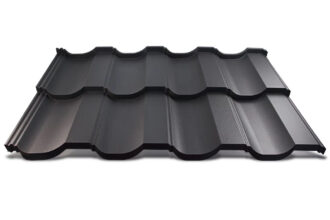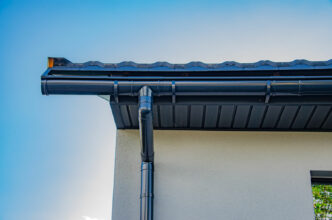Types of trapezoidal sheet metal
Trapezoidal sheet metal is aesthetically pleasing, damage-resistant and relatively inexpensive, which accounts for its enduring popularity. This type of roofing is used not only on the roofs of private houses but also on the roofs of terraces, garages or gazebos. Many trapezoidal sheet metal variants are available on the market, differing in profile height or material, among other things. Find out how to choose the suitable model for your building!
Trapezoidal sheet metal – what are its characteristics?
Trapezoidal sheet metal is a roofing and cladding material characterised by trapezoidal ribs. This makes the sheet metal very strong and rigid. The thickness of the steel core of the sheet metal usually ranges from 0.4 mm to 1.5 mm. The core is made from steel or aluminium and then covered with a protective coating. The most popular trapezoidal sheet metal is made of galvanised steel, aluminium zinc and also with a polyester coating.
In addition to its low price, trapezoidal sheet metal stands out for its excellent performance. It is also lightweight, allowing it to be installed even on weaker roof trusses. Thanks to its protective coating, trapezoidal sheet metal is also resistant to weathering, moisture and corrosion. This type of covering is used extensively in both housing, agriculture and industry.
What materials are used to make trapezoidal sheet metal?
Trapezoidal sheets are made of steel or aluminium, but a variety of options are available for additional roofing.
- Galvanised sheet metal – zinc dramatically increases the material’s resistance to rust and moisture, directly impacting the sheet’s lifespan. Protection against rust is critical, as this is the leading cause of coating deterioration. Proper roofing protection has a bearing on the condition of the entire structure.
- Alloy zinc sheet metal – In this option, the core of the sheet is coated with a solid mixture of aluminium, zinc and silicon. Combining these materials results in the formation of aluminium on the sheet’s surface. It is a layer that effectively protects the trapezoidal sheeting from corrosion, snow or rain. Alloy zinc sheet metal has better properties and is more durable than galvanised sheet.
- Polyester-coated sheet metal – a polyester coating increases the plate’s resistance to corrosion and the adverse effects of extremely low and high temperatures. In addition, the polyester coating is smooth and glossy, which positively affects the appearance of the coating. This option is most commonly used in residential construction.
In terms of cost, galvanised trapezoidal sheet metal is the best, with a price per m2 that can be up to 30% lower than the alloy zinc variant and up to twice as low as polyester-coated sheet metal.
Division of trapezoidal sheet metal by profile height
Before buying a trapezoidal sheet, check the profile height information. This is very important for the integrity of the whole structure. Manufacturers provide the dimensions of trapezoidal sheet metal, so making the right choice should be easy. Naturally, all models are available in different finishes and colours. Which variants of trapezoidal sheet metal are the most popular?
- T-8 is a sheet metal with a trapezoidal profile height of exactly 8 mm. This sheet metal is most often used for smaller roofing and facades of large-scale structures such as halls or garages.
- T-12, which is corrugated sheet metal with a profile height of 12 mm. Its use is similar to the T-8 variant.
- T-14, which is a sheet metal with a profile height of 14 mm. This option is widely used for facades, gates and roof underlays.
- T-18 is a sheet metal used primarily on roofs with a pitch of at least 9°. It is a straightforward and durable option with a trapezoidal profile height of 18 mm.
- The T-35 and T-55 are trapezoidal sheet metals with 35 and 55 mm profile heights, respectively. They are mainly used in industrial, commercial and manufacturing buildings with long-span roofs. These trapezoidal sheet metal variants are very rigid and strong.
Trapezoidal sheet metal is manufactured as sheets of a specific length and width. For steel sheets metal, the maximum length can be as long as 12 m, and for aluminium sheets, 7 m. The width of a single sheet, depending on the variant chosen, can range from 50 to even 160 cm.
Which trapezoidal sheet metal will be best for the roof?
The choice of a particular trapezoidal sheet metal should be closely related to the type and size of the building where the material will be installed. A roof of a medium-sized residential building will be successfully covered with sheet metal with a profile height of 18 mm. Higher-profile sheet metal should be used primarily for large-scale properties (warehouse halls, shopping malls, multi-family houses). This applies to both roofs and facades.
If you are looking for a plinth sheet metal, choose a low-profile option (e.g. T-7 ). On the other hand, trapezoidal sheet metal with profiles adapted for this type of surface is most commonly used for facades. One of the most versatile variants is the T-18 sheet metal, which can easily be used for a summerhouse, garage or allotment house. Choosing the suitable sheet metal significantly impacts the airtightness of the roof and façade. So, you should buy the material and ensure it is installed correctly. You should hire a team of experienced professionals to do this, as working alone requires specialised skills and equipment.
Trapezoidal sheets, both for roofs and facades, can be found in our range! Trapezoidal sheets for both roofs and facades are available in our range! With our sheet metals, you can tightly cover a garage, shed, commercial or industrial building, as well as a small architectural roof.


